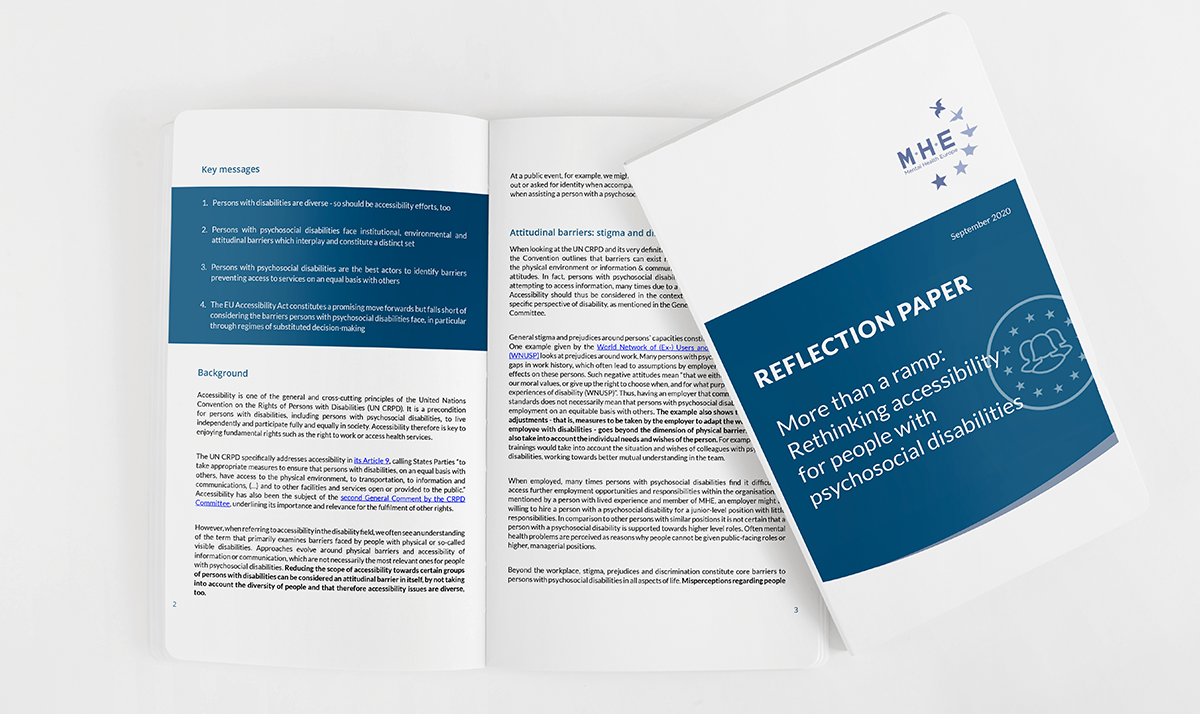More than a ramp: Rethinking accessibility for people with psychosocial disabilities


Ahead of the second Disability Strategy 2020-2030 developed by the European Commission, Mental Health Europe (MHE) has prepared its reflection paper on accessibility from a psychosocial perspective. The position can be used by stakeholders, particularly the EU institutions and the Member States, as a working document and baseline for the initial discussions around accessibility and what barriers persons with psychosocial disabilities can encounter.
Accessibility is one of the general and cross-cutting principles of the United Nations Convention on the Rights of Persons with Disabilities (UN CRPD). It is a precondition for persons with disabilities, including persons with psychosocial disabilities, to live independently and participate fully and equally in society. Accessibility, therefore, is key to enjoying fundamental rights such as the right to work or access health services.
However, when referring to accessibility in the disability field, we often see an understanding of the term that primarily examines barriers faced by people with physical or so-called visible disabilities. Approaches evolve around physical barriers and accessibility of information or communication, which are not necessarily the most relevant ones for people with psychosocial disabilities. Reducing the scope of accessibility towards certain groups of persons with disabilities can be considered an attitudinal barrier in itself, by not taking into account the diversity of people and that therefore accessibility issues are diverse, too. At a public event, for example, we might imagine that a personal assistant will not be called out or asked for identity when accompanying a person with a physical disability – however, when assisting a person with a psychosocial disability questioning is likely to increase.
Attitudinal barriers: stigma and discrimination remain central
General stigma and prejudices around persons` capacities constitute barriers in themselves. One example given by the World Network of (Ex-) Users and Survivors of Psychiatry (WNUSP) looks at prejudices around work. Many persons with psychosocial disabilities face gaps in work history, which often lead to assumptions by employers which have negative effects on these persons. Such negative attitudes mean “that we either have to lie, against our moral values, or give up the right to choose when, and for what purposes, to disclose our experiences of disability (WNUSP)”. Thus, having an employer that commits to accessibility standards does not necessarily mean that persons with psychosocial disabilities can access employment on an equitable basis with others. The example also shows that reasonable adjustments – that is, measures to be taken by the employer to adapt the workplace to an employee with disabilities – goes beyond the dimension of physical barriers and should also take into account the individual needs and wishes of the person. For example, diversity trainings would take into account the situation and wishes of colleagues with psychosocial disabilities, working towards better mutual understanding in the team
Legal barriers: substituted decision-making and coercive practices underlie accessibility challenges
The UN CRPD also makes references to barriers that can be found in legal and political frameworks, such as laws or policies that explicitly discriminate on the basis of disability. These legal barriers pose particular challenges to persons with psychosocial disabilities. Systems of substitute decision-making, in which the legal capacity of a person is partially or entirely restricted and the person is placed under full or partial guardianship, are one example of legal barriers for persons with psychosocial disabilities to access their rights. Being denied legal capacity can mean not being allowed the right to make decisions in many aspects of life, such as the right to get married, to attend mainstream education, to politically participate through voting or demonstrating, or to work. Unfortunately, all countries in Europe still maintain some type of substitute decision-making schemes as a means of last resort, although there are promising developments in some Member States of the European Union (EU). In addition, many persons with psychosocial disabilities are challenged with measures of forced institutionalization and forced treatment. Among others, forced institutionalization, itself non-compliant with the CRPD, prevents people from participating in society and do not have enough control over their lives and over decisions which affect them. As long as legal barriers exist, allowing for such non-consensual practices, people with psychosocial disabilities will not enjoy access to full and equal participation in all aspects of life.
Conclusion- a long way to go to ensure a fully accessible environment
Physical barriers are one of the many elements that need to be addressed while exploring what accessibility means for people with disabilities, including people with psychosocial disabilities. Legal barriers, such as the elimination of all types of substituted decision-making, as well as attitudinal barriers must be taken into account. Any effort on promoting the accessibility should go hand in hand with the need to raise awareness on less visible barriers and the need to invest in mental health literacy. In other words, any effort on Article 9 of the UN CRPD thus cannot be sufficient without efforts on Article 8 on raising awareness working towards respect for the rights and dignity of persons with disabilities.
With regards to persons with psychosocial disabilities, this would mean for example creating an environment in which people are not discriminated on the basis of their mental health experiences, can actively raise awareness about human diversity and human experience, and combat judgmental labels including those from a medical perspective. Persons with psychosocial disabilities themselves are the best actors to identify the support they need to overcome accessibility barriers, moving a step closer to building a fully inclusive society. To build a fully inclusive society, it is key to acknowledge the diversity of human experiences.
For more details, please contact Jonas Bull, Policy and Research Officer, Mental Health Europe, jonas.bull@mhe-smeorg
Stay connected
Get our latest news, personal stories, research articles, and job opportunities.